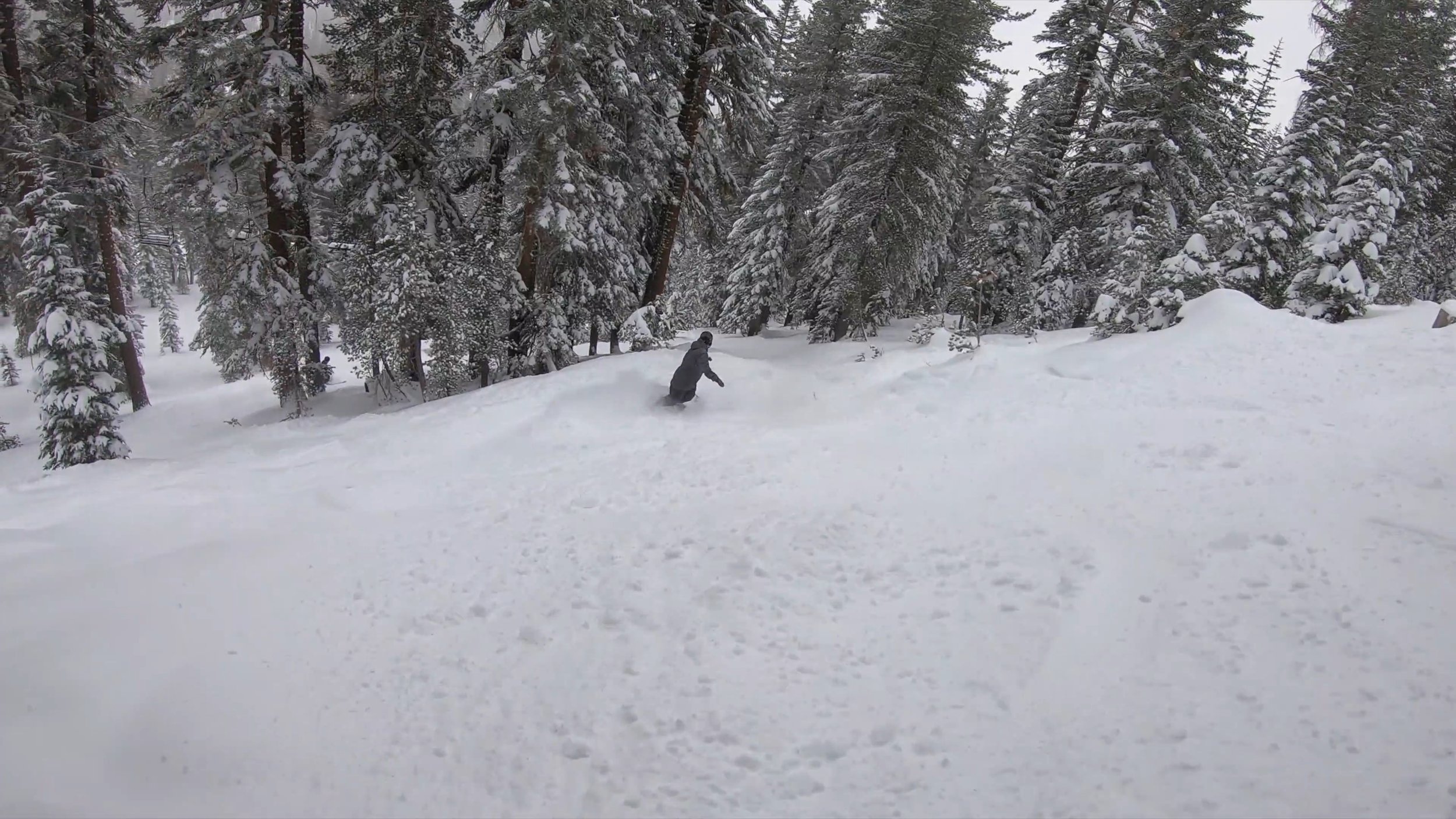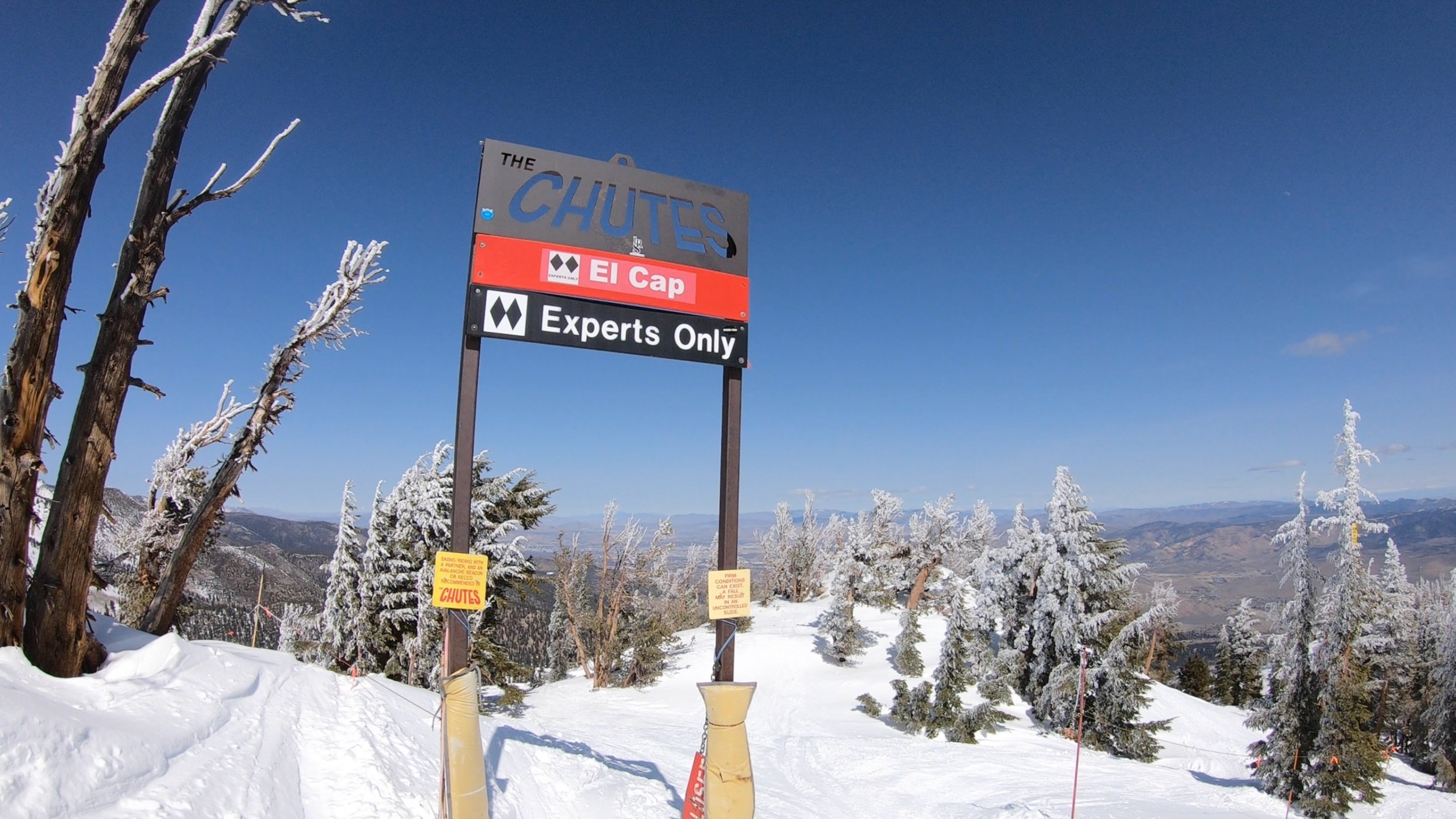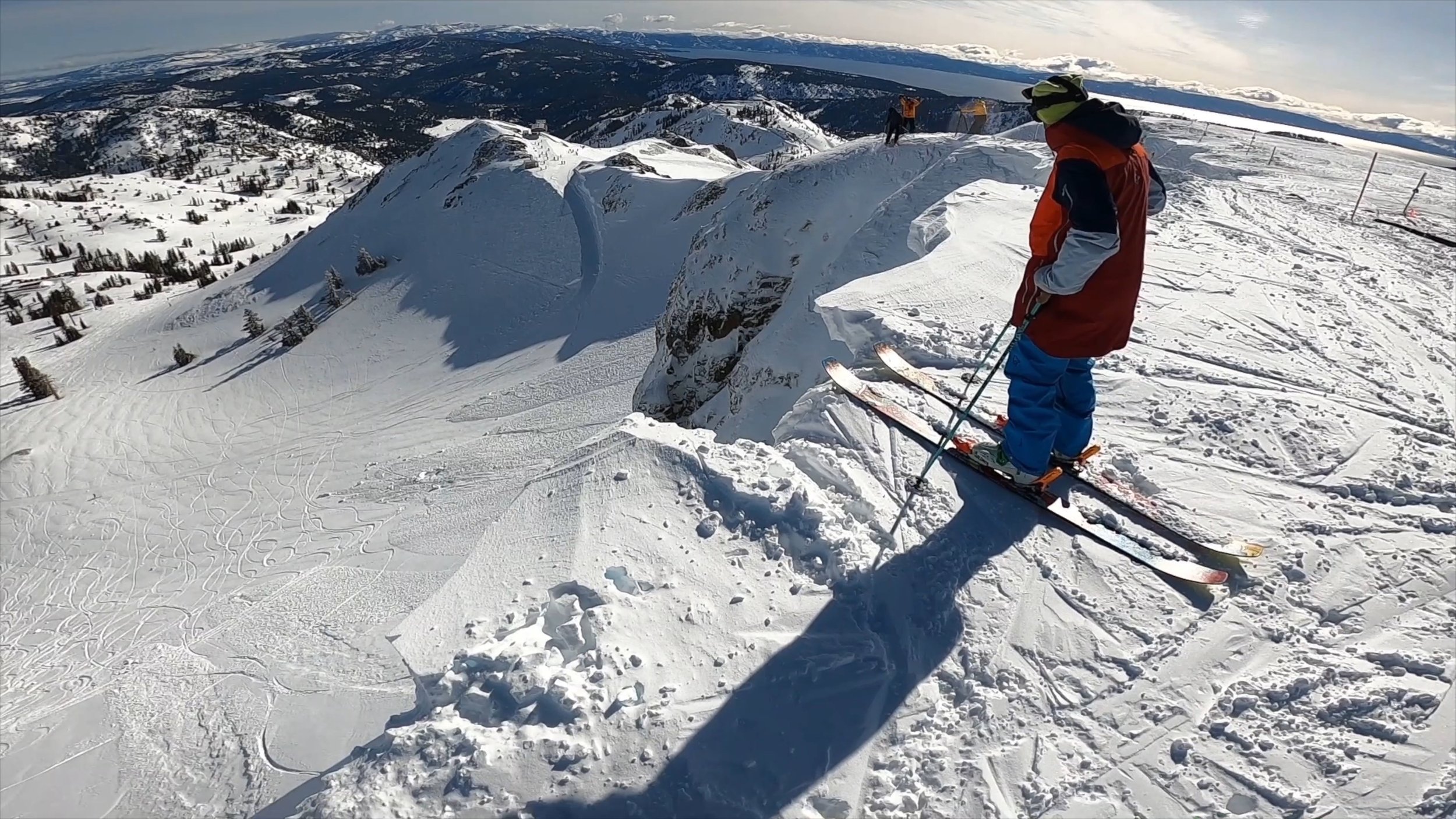Lake Tahoe Ski Resorts Ranked for Experts: Forgettable to Truly Extreme
For generations, Lake Tahoe has been known for sunny slopes, stunning views, and easy Bay Area access. But the region is also home to some of the most insane skiing in the world, with formidable lines, obstacles, and cliff drops that will leave even the most tenured skiers and riders balking. There’s a reason why some of the most legendary snow sports icons ever have come from this region.
But while there’s no doubt that Tahoe as a whole has plenty for experts, not all of its mountains are created equal. So which ones are best for pushing yourself to the limit, and which, plainly, aren’t? Let’s take a look.
#9: Northstar
Coming in at the bottom of this list we have Northstar, a resort that’s not fully lacking for challenge but delivers a much less technical experience than its destination Tahoe brethren.
Let’s start with the positives, and there are a couple: Northstar’s Backside and Lookout Mountain zones host some long, demanding mogul runs—although anywhere between a third to half of these tend to be groomed depending on the day—and the resort’s woods are home to some awesome steep glades, with plenty of tree terrain across the sizable footprint. Finally, while not technically in bounds, there is a short, cool area called Rabbit Ridge with a few cliffs if you can find them—although this area is usually only doable once per season if you’re lucky.
But there are no double-black-diamond runs at Northstar, and there’s a reason for that. The resort is not even worth going to for any serious expert, and while the most challenging runs are steep and somewhat long, none of them can offer truly precipitous pitches. Assuming reasonable conditions, advanced-level skiers and riders should be able to handle almost everything at the resort.
Unfortunately, the expert experience has recently gotten worse than it already had been. Up until 2022, the most technical pitch at the resort was arguably the Corridor run down the Comstock Express lift line, which included some rocks, tree stumps, and narrow segments where quick decision-making was required. But when they replaced the Comstock quad with a six-pack, they combined Corridor with the much wider Grouse Alley run, effectively removing a lot of the technicality.
Northstar has some great glades and a large footprint, but for experts, you can essentially write it off for your next Tahoe trip. Northstar already has enough crowds, so if double-black-diamonds are your preferred method of downhill travel, we recommend you leave this resort to the Bay Area families.
#8: Diamond Peak
Next up we have Diamond Peak, a Tahoe-adjacent resort that’s much smaller than the other resorts on this list but not entirely lacking in challenge. Diamond Peak’s 400-acre skiable footprint is heavily vertically-oriented, and while it does feature a few solid mogul runs, like Northstar, this lake-adjacent resort stands out for its woods. As long as snow conditions allow, all of Diamond Peak’s fairly steep upper mountain is skiable as glade terrain—and depending on snow conditions, the trees often host significant hidden obstacles such as rocks.
Much of Diamond Peak’s footprint will be doable for advanced skiers and riders, but the resort cements itself clearly above Northstar for experts thanks to its Solitude Canyon zone. This area takes months to accumulate enough snow to open, but once good to enter, it features steep, narrow lines across numerous obstacles such as rocks and cliffs. Most of Solitude Canyon can be directly lapped via the Crystal lift, but a few of the upper-most lines require a brief hike.
So Diamond Peak may not be as tough as the resorts higher up on this list, but at least when conditions allow, it does offer some truly expert-oriented terrain that should at least keep tenured visitors busy for a while.
#7: Homewood
As the closest ski resort to Lake Tahoe—the main base sits literally feet from this massive, unfrozen lake—Homewood is one of the most stunningly beautiful ski resorts on the continent. But while many of its slopes may seem mellow, Homewood has a wild side to it too.
Like with Northstar, all of Homewood’s truly lift-served slopes are doable for advanced-level guests. But if you venture out the southern reaches of the resort, you’ll find Homewood’s Quail Face—which not only hosts a consistent, truly expert-level pitch of greater than 50 degrees, but does so while providing an extraordinary, almost-entirely-comprehensive view of Lake Tahoe. Getting both to and from this area requires prolonged traversing, so it’s not for those who aren’t prepared for a real adventure, but if you can handle the terrain, it’s totally worth it.
So while Homewood may not offer the same quantity of expert slopes as the resorts higher up on this list, it’s worth stopping by for a day exclusively to ski or ride Quail Face, assuming conditions allow. And while there won’t be cliffs or chutes elsewhere on the mountain, the resort’s woods and mogul runs will probably be enough to keep tenured guests busy after the hike-out from that run.
#6: Sierra-at-Tahoe
Next up on this list we have Sierra-at-Tahoe, a resort that was historically known for its woods terrain, but has recently seen a massive wildfire-caused footprint shift that’s turned many of these woods into high-alpine bowls. But the one area that was chiefly spared from the fire damage was Sierra’s Huckleberry Canyon, a terrain zone that hosts what are probably the first truly extreme lines we see on this list.
The rock-riddled Huckleberry Canyon is crowned by a massive cornice, and if you enter the upper gates of this area, you’ll likely have to clear this cornice to get anywhere else on your run. Getting down this cornice, which does require a very brief hike to reach, mandates tight, technical turns at a minimum—and for particularly adventurous guests, it provides plenty of opportunities for mandatory straightlining or cliff drops when conditions allow.
However, Huckleberry Canyon suffers from one substantial downside: it’s perennially closed. This area takes tons of snow to fill in, and the resort can go months without opening it—and in some particularly bad seasons, patrol may not open the canyon at all.
But even if the Huckleberry Gates are closed, Sierra does offer a couple of expert-oriented trees and bowls in upper-mountain areas, with unique boulder formations in the ground that mean the runs down will never be too bland. Sierra-at-Tahoe’s expert terrain is less abundant and reliable than the resorts higher up on this list, but if you get there on the right day, there’s no doubt it will be a good time.
#5: Heavenly
Next up on this list we have Heavenly, another ski resort that sits immediately adjacent to Lake Tahoe and comes with outstanding views to boot.
At a first glance, one could write off Heavenly’s challenge footprint as fairly similar to Northstar’s, with most of its footprint offering difficult trees and mogul runs, but not much that’s too tough for advanced-level skiers and riders.
But where Heavenly really stands out is in its far-northeastern reaches, where the resort calls home to the experts-only, gate-accessed Mott and Killebrew Canyon areas. Mott Canyon is the shorter and easier-to-access area of the two, but still it’s no joke, with every single path down this area involving very steep, narrow terrain that requires steady composure to complete successfully.
Killebrew Canyon takes everything at Mott Canyon and turns it up a notch, comprising precipitously demanding lines ranging in technicality from expert to truly extreme. Severely tight turns and hidden elements such as rocks are standard, and depending on which gate you enter, you may find yourself facing situations of mandatory straightlining or steep cliff drops—or combinations of both.
Heavenly’s expert challenges are much more concentrated than some of its competitors, and in the case of Killebrew Canyon, the long, time-consuming hikeouts make the area really impractical to lap. And while their north-facing nature helps preserve snow, these areas are subject to somewhat variable openings. But if you’re an expert and you find yourself at Heavenly, the resort’s hardest terrain zones are a lot tougher than most people give it credit for.
#4: Mount Rose
As the closest ski resort to Reno, Mount Rose tends to attract a budget-conscious, family-oriented crowd from that area. The bulk of the footprint is among the most mellow in Tahoe, with both the front side and Winters Creek back side hosting very little terrain that would qualify above advanced-level difficulty.
But the challenge level takes a jarring step up when it comes to the Mount Rose Chutes, which are home to some of the most technically-pitched terrain in Tahoe. When they’re open, these lines are not for the faint of heart, and depending on which path you take, you could end up feeling like the ground has given out below you. You won’t be sending 50-foot cliff drops in the Chutes, but straightlining is required on the hardest runs. And these chutes are among the easiest expert runs in Tahoe to lap, with no hiking required, with just two lift rides required to get back to any of these runs.
However, like the other ski resorts we’ve covered so far, Mount Rose’s Chutes suffer from variable terrain openings. They won’t be closed for an entire season, but they do take a few months to fill in during bad seasons, and if the Chutes are closed, Mount Rose’s expert terrain openings are essentially nil.
The Mount Rose Chutes only make up 10% of the resort’s footprint, but they’re extensive, accessible, and most importantly, perilous enough to help the resort beat out more than half of its destination competitors. The resorts further up on this list do offer more widespread extremes, but as far as lappable expert challenges when the Chutes are open, you won’t go wrong with Mount Rose.
#3: Sugar Bowl
Next up on this list we have Sugar Bowl, one of the oldest ski resorts in Tahoe. At a first glance, Sugar Bowl doesn’t seem like it should belong this high up on a Tahoe expert list. After all, the resort is known for its family-friendly vibe and Disney-influenced history.
But tenured experts should not underestimate Sugar Bowl. The resort may not offer the longest vertical drop out there, but its expert terrain is some of the most technical in the region. You have some areas with typical steep pitches and leg-burning moguls, but Sugar Bowl really stands out for its rock-formed extremes, making for cliffs, couloirs, and chutes, even directly off the lifts. Depending on where you end up, prepare for some mandatory straightlining.
But like at many of the other resorts we’ve covered so far, a number of Sugar Bowl’s extremes are subject to extremely variable opening schedules. Sugar Bowl’s Palisades—not to be confused with those at Palisades Tahoe—host bloodcurdlingly extreme terrain, but they’re so inconsistently open that the resort fails to drop the rope at all in many seasons. The expert-oriented Summit chair also rarely spins, although you can occasionally hike to it. But unlike some of the resorts we’ve already discussed, at least some variety of seriously technical terrain does tend to open by the core season each year.
Sugar Bowl tends to fly more under the radar for experts than some of the other resorts on this list, but if you’re looking for a challenge—and you want access to extremes that are even easier to lap than Mount Rose’s—you won’t go wrong.
#2: Kirkwood
As we get into the top two on this list, we start to enter resorts that offer truly copious amounts of drastic terrain. And while Kirkwood may only offer a 2,000-foot vertical drop, its daunting, rock-formed footprint makes it a formidable playground for experts looking to push themselves to the limit.
Chutes, couloirs, and cliffs exist across multiple resort areas, and in some cases, these incredibly technical obstacles can materialize in places you’d least expect them. The vast majority of double-black-diamond runs require either dropping in from a cornice or navigating perilously steep mogul fields at a minimum—and with maybe less effort than what feels is right, guests can find lines that require prolonged mandatory straightlining or aggressively colossal cliff drops—or a combination of both.
So while Kirkwood isn’t tall enough to offer true endurance runs, the resort is without a doubt an expert’s paradise, with more opportunities to get yourself into profound trouble than all the other mountains we’ve covered so far by a long shot. But there’s one iconic Tahoe ski resort that just can’t be beat for its extremes, and if you’ve been to the region before, you probably already know what it is.
#1: Palisades Tahoe
Plenty of Tahoe mountains offer impressive expert terrain, but there’s no ski resort that does it better than Palisades Tahoe. The resort boasts stunningly extreme in-bounds slopes, including cliffs, chutes, and couloirs that one could only dream of skiing or riding at your typical resort. But perhaps more importantly, these prohibitively intense slopes span extensive sections of the resort, meaning they’re not located in just one or two areas—and provided conditions allow, guests will have access to the resort’s extremes no matter where on the mountain they find themselves.
Palisades Tahoe doesn’t have the longest vertical drop, but it’s no slouch when it comes to traditional expert runs either. Guests who don’t want to deal with rocks, mandatory straightlining, or cliff drops can find traditional double-black-diamond runs all across the mountain—and yes, we do have to note that the resort introduced a double-black-diamond rating for the first time in 2022, after holding off on doing so for decades (the Alpine Meadows side technically did use double-blacks until 2012, but that was under different management).
Critically, the expert and extreme terrain at Palisades Tahoe isn’t just localized to the bigger and better-known Palisades side, but also to the Alpine Meadows side, which is now physically linked by the Base-to-Base Gondola. Alpine Meadows may have a shorter vertical drop than the Palisades side, but its toughest runs are nearly as extreme, meaning guests can find themselves overlooking the same prolonged mandatory straight lines and similar multi-foot cliff drops to those elsewhere at the resort. For the record, if Alpine Meadows were still a separate entity, we’d rank it just below Kirkwood, which we’d say just beats it out in terms of the concentration of extreme-level lines.
Like other mountains in the region, Palisades Tahoe’s expert and extreme terrain offerings do suffer from somewhat variable opening schedules—and during below-average snowfall seasons, several of the resort’s most daunting routes may not open at all. But if you hit Palisades Tahoe at the right time, the resort has enough catastrophically difficult lines to beat out all the other mountains on this list combined, and it rightfully earns its place as the top expert mountain in the region.
Final Thoughts
So that’s our rank-order guide for experts in Lake Tahoe. You won’t go wrong with many of the mountains in this formidable region, but the best mountains are truly world-class, standing out for both the quality and quantity of their hardest terrain. Tahoe may have its problems, but if you’re a truly tenured skier or rider, these issues are probably worth overlooking to get a taste of just what this region has to offer.
How’d we do? Would you change the order? We’d love to hear from you, so if you have any thoughts, hit us with a comment below!
For more information on these resorts, check out our comprehensive Lake Tahoe mountain reviews. If you’re interested in seeing how they compare to other similar mountains, check out our California, West Coast, and overall rankings.









